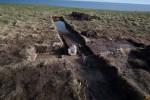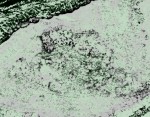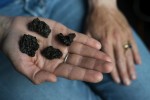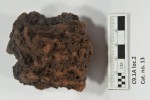 A test excavation in the peninsula of Point Rosee in southwestern Newfoundland, Canada, has unearthed evidence of a Viking settlement. If the site is confirmed as Norse, it will be the second of its kind and history books will have to be rewritten because Point Rosee is significantly more to the west than the Vikings were thought to have traveled.
A test excavation in the peninsula of Point Rosee in southwestern Newfoundland, Canada, has unearthed evidence of a Viking settlement. If the site is confirmed as Norse, it will be the second of its kind and history books will have to be rewritten because Point Rosee is significantly more to the west than the Vikings were thought to have traveled.
 Two Icelandic Sagas — the Saga of Eric the Red and the Saga of the Greenlanders — recount how Leif Eriksson discovered a land to the west called Vinland and how Thorfinn Karlsefni followed in his footsteps and attempted to found a settlement in Vinland. Very little archaeological evidence has been found to support the oral and literary tradition (the sagas were written down 250 years after the events they describe). In 1960, the first and so far only verified North American Viking site was discovered in L’Anse aux Meadows, a coastal settlement on the northernmost tip of Newfoundland, 300 miles northeast of Point Rosee.
Two Icelandic Sagas — the Saga of Eric the Red and the Saga of the Greenlanders — recount how Leif Eriksson discovered a land to the west called Vinland and how Thorfinn Karlsefni followed in his footsteps and attempted to found a settlement in Vinland. Very little archaeological evidence has been found to support the oral and literary tradition (the sagas were written down 250 years after the events they describe). In 1960, the first and so far only verified North American Viking site was discovered in L’Anse aux Meadows, a coastal settlement on the northernmost tip of Newfoundland, 300 miles northeast of Point Rosee.
 Since then, a great many searches have turned up very meager evidence, none of it confirmed, of Norse settlement, but people keep looking. The Point Rosee site was pinpointed on satellite images by space archaeologist Sarah Parcak who has made the news recently because a) space archaeologist is probably the greatest job description of all time, and b) she won the $1 million TED prize last year for her work in locating ancient Egyptian sites and tracking looter activity from the skies. Parcak was enlisted by the PBS science program NOVA to scour satellite images from Baffin Island to Massachusetts in the search for Viking settlements in North America. She found hundreds of possibilities and one stand-out that appeared to have rectilinear structures hidden under vegetation.
Since then, a great many searches have turned up very meager evidence, none of it confirmed, of Norse settlement, but people keep looking. The Point Rosee site was pinpointed on satellite images by space archaeologist Sarah Parcak who has made the news recently because a) space archaeologist is probably the greatest job description of all time, and b) she won the $1 million TED prize last year for her work in locating ancient Egyptian sites and tracking looter activity from the skies. Parcak was enlisted by the PBS science program NOVA to scour satellite images from Baffin Island to Massachusetts in the search for Viking settlements in North America. She found hundreds of possibilities and one stand-out that appeared to have rectilinear structures hidden under vegetation.
 Parcak and Canadian experts explored the site this summer. A magnetometer survey found a spot with high iron readings that according to the satellite images was surrounded by those buried straight-line features. The team dug exploratory trenches on the spot. They unearthed turf walls and a shallow pit. In front of the pit was a fire-cracked boulder. There also found ash residue, 28 pounds of slag and lumps of roasted iron ore. The evidence points to this being a hearth used to process bog iron, ore carried by rivers to wetlands where it forms metal deposits. The Vikings weren’t miners, but they needed a great deal of iron to maintain their ships. A replica longship in the Viking Ship Museum in Roskilde, Denmark, has 7,000 iron nails keeping it together. That converts to 30 tons of raw ore just to supply enough nails for a single ship. That’s a lot of bog iron.
Parcak and Canadian experts explored the site this summer. A magnetometer survey found a spot with high iron readings that according to the satellite images was surrounded by those buried straight-line features. The team dug exploratory trenches on the spot. They unearthed turf walls and a shallow pit. In front of the pit was a fire-cracked boulder. There also found ash residue, 28 pounds of slag and lumps of roasted iron ore. The evidence points to this being a hearth used to process bog iron, ore carried by rivers to wetlands where it forms metal deposits. The Vikings weren’t miners, but they needed a great deal of iron to maintain their ships. A replica longship in the Viking Ship Museum in Roskilde, Denmark, has 7,000 iron nails keeping it together. That converts to 30 tons of raw ore just to supply enough nails for a single ship. That’s a lot of bog iron.
 Only one other bog iron smithy has ever been found in North America: L’Anse Aux Meadows. Native Newfoundlanders did not practice this kind of metallurgy, nor is there any other evidence (flint, pottery) of indigenous or later European settlers present at the site.
Only one other bog iron smithy has ever been found in North America: L’Anse Aux Meadows. Native Newfoundlanders did not practice this kind of metallurgy, nor is there any other evidence (flint, pottery) of indigenous or later European settlers present at the site.
It doesn’t look like much …, [b]ut lead archaeologist Sarah Parcak says the site is almost certainly only one of two things:
“Either it’s … an entirely new culture that looks exactly like the Norse and we don’t know what it is,” she told The Washington Post in a phone interview. “Or it’s the westernmost Norse site that’s ever been discovered.”
The excavation team will return to Point Rosee this summer to dig for more history-making treasure. Vikings Unearthed, the NOVA episode that documented their work last year, premiers on Wednesday, April 6th, on PBS in the United States. UK viewers get it two days earlier, Monday, April 4th, on BBC One. It will also be available streaming on PBS’ website starting Monday at 3:30 PM.
Here’s a preview of the episode:
[youtube=https://youtu.be/6ScKd179HkQ&w=430]